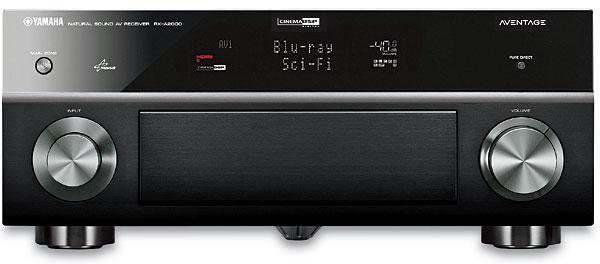Does the YPAO equalize the subwoofer?
Can I have my cable box via HDMI go through the video processor, while keeping Blu-rays via another HDMI input (duh,haha) go untouched?
Thanks for any reply.

On the Right Foot
Surround aficionados often look at the front and back panels of an A/V receiver under consideration. But how often do we flip over the AVR and look at its bottom? If you do that with the Yamaha Aventage RX-A2000, you’ll see a total of five feet. The fifth foot, Yamaha’s press release explains, is there “to improve structural rigidity, reduce vibration, and improve sound.” Some Aventage models also include double-bottom construction and other improved parts. With all these changes, Yamaha is confident enough to add an extra year to the warranty, now three years for Aventage AVRs.
The company is making greater-than-average claims for the sound quality—over and above the usual PR declamations—for Aventage A/V receivers. Thus this review is a fairly intriguing assignment for someone with a wide frame of reference in Yamaha AVRs. Would this one really sound any different, any better?
What’s Resting on the Fifth Foot
The RX-A2000 ($1,500) is one of five new A/V receivers with the new Aventage designation. Don’t bother with your dictionary—it’s an acronym, more or less, for A/V ENTertainment for the new AGE. The other models include the step-up RX-A3000 ($1,900) and three lower-priced models: RX-A1000 ($1,100), RX-A800 ($800), and RX-A700 ($650). While you’ll get a little more rated power and more HDMI video adjustments in the step-up model, the model under review has most of the vaunted build-related features.
This AVR is neither especially large nor fancy. Its front panel has the usual two knobs for source select and volume with plenty of other controls beneath a flip-down panel. Right from the front panel, you can navigate menus, select listening modes, hop among zones, or plug in an array of things including HDMI and USB sources.
Entering the graphic user interface is like walking into a sleekly designed room. It’s orderly, tasteful, and makes tactful use of color. Structurally, it uses an increasingly popular design with a vertical navigation column at left that pushes out horizontal rows of controls. The remote control is also above average; it makes good use of button shape, size, color, and background. Three buttons at top include power switches for both the selected source component and the AVR itself. Between them is a backlit button that shifts between modes. When the button glows orange, the remote controls the AVR. When the button glows green, the remote controls the selected source component. An LCD confirms source selections and momentarily shifts into “receiver” when you activate, say, the volume control. More controls are below a panel at the bottom.
I review so many A/V receivers that, however strong in other respects, come with remotes that say “we did our best on the receiver, but by the time we got around to designing the remote, we were out of funds, out of ideas, out of time, it was late at night, the conference-room table was strewn with pizza boxes and Pepto-Bismol bottles, we were missing our families, we were confronting certain existential questions that don’t come up in the morning and the afternoon, and frankly, we just didn’t care anymore. So here it is, a piece of plastic covered with identical tiny buttons.” This AVR remote says something decidedly different: “We overlooked nothing.”Interestingly, this is the first AVR I’ve reviewed that didn’t come with a printed manual.
The carton did include the manual on CD in PDF format as well as a small printed quick guide. In some ways, PDF manuals are an improvement: They let you upsize the text or search for specific terms.
Licensed features include HQV Vida video processing, Windows 7 compatibility, and DLNA certification to access content from a network-connected PC or Internet radio. Other listening options include Sirius satellite radio and the Rhapsody music subscription service. For iPod/iPhone use, Yamaha offers a choice of docks, either wired (YDS-12, $100) or wireless (YID-W10, $149).

Does the YPAO equalize the subwoofer?
Can I have my cable box via HDMI go through the video processor, while keeping Blu-rays via another HDMI input (duh,haha) go untouched?
Thanks for any reply.


Thank you Scott!
A couple more...
Can I assume that the sub equalization in the receiver be equal or close to the PBK on a Paradigm SUB 10?
On the RX-A2010, should I leave video processing to my Sony 55HX701?
I know you're busy and I appreciate any info you provide.

Likewise with the video processing. Watch some standard-def and 1080i content with the AVR's processing on and off (in the latter case, the TV will do the processing) and see which one looks better.